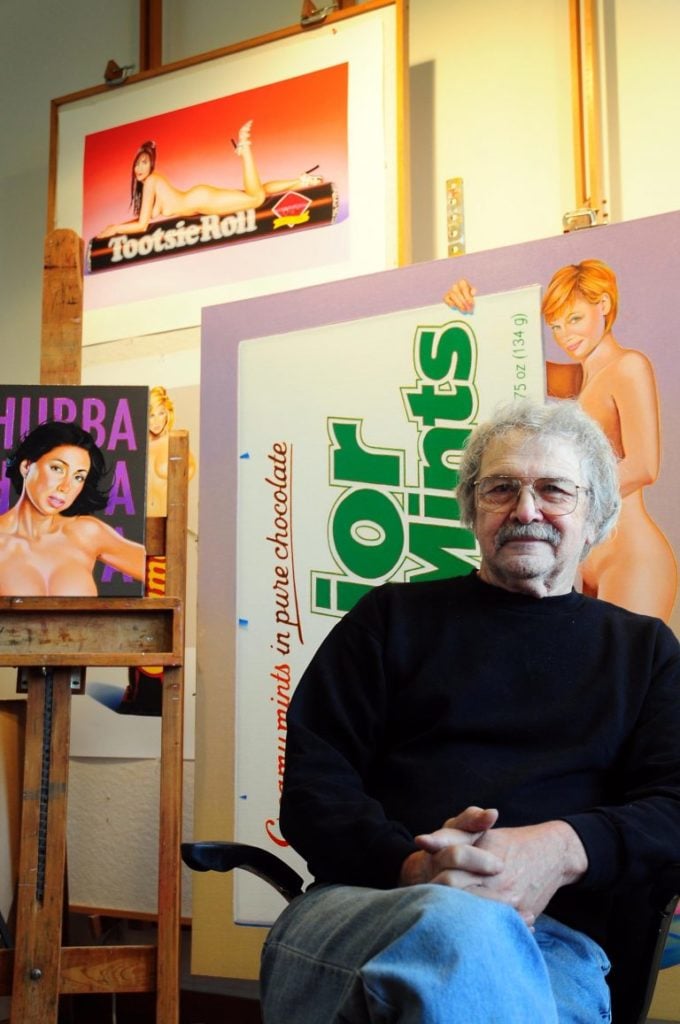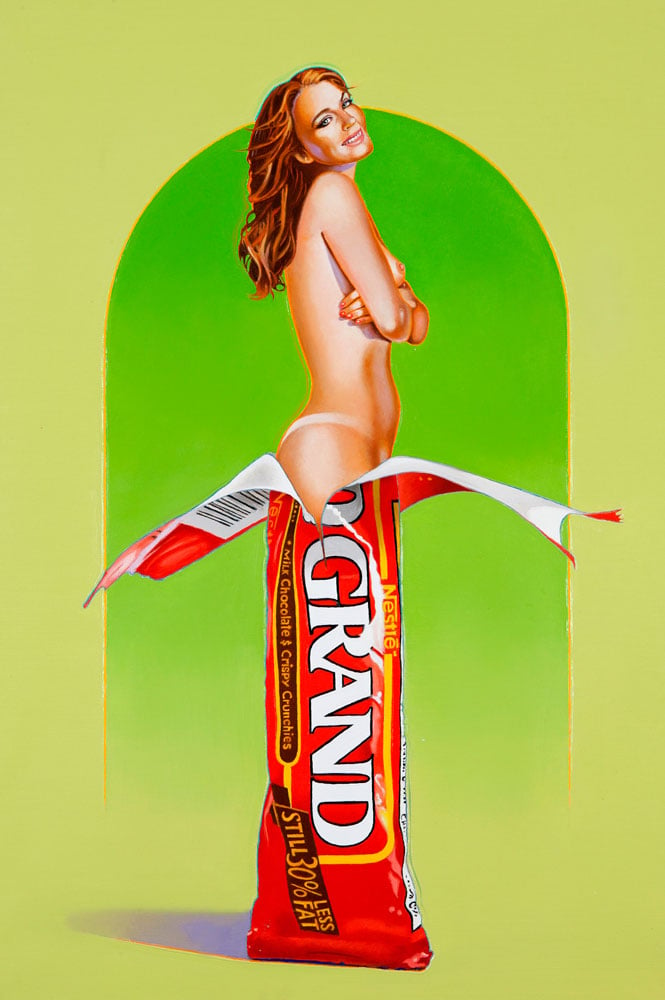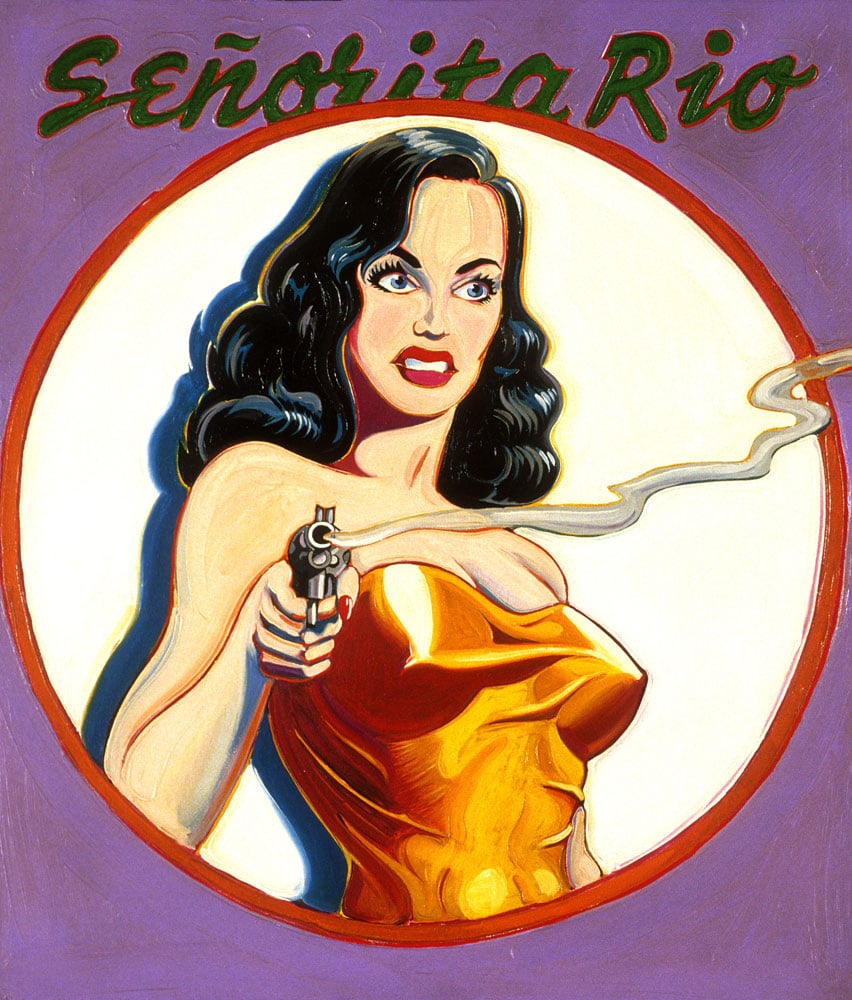
People
Pop Artist Mel Ramos, Best Known for His Racy Depictions of Women and Candy, Dies at 83
The artist satirized pin-up girls in his paintings of nude women.

Pop artist Mel Ramos, whose art was known for its striking juxtaposition of naked women with larger-than-life commercial products, has died at age 83. According to his daughter and studio manager, Rochelle Leininger, the cause of death was heart failure.
While he never achieved the same level of fame as his fellow Pop art pioneers, Ramos was an important part of the first generation of American Pop artists. He was one of 12 artists, along with Andy Warhol and Roy Lichtenstein, in the Los Angeles County Museum of Art’s 1963 Pop art show that showcased the burgeoning new movement, with Ramos’s paintings appropriating comic book imagery of female superheroes.
“That was the beginnings of Pop art,” Louis K. Meisel told artnet News. Meisel, who owns the eponymous Louis K. Meisel Gallery in New York, has been Ramos’s dealer since 1971. Ramos originally showed with Leo Castelli, but the gallery wasn’t interested when the artist started focusing on more overtly sexual female nudes, satirizing the traditional commercial pin-up girl.
“I guess that was pretty aggressive back in 1965,” said Meisel, who was introduced to Ramos’s work by Castelli’s former associate director, Ivan Karp. “He called me and said ‘I have a really great artist for you,’ but he didn’t tell me who. Mel Ramos showed up at the gallery in this big fur coat with this big afro haircut and he showed me his work. I took him in immediately and I’ve been representing him ever since.”

Mel Ramos, 100 Grand (2012). Courtesy of Louis K. Meisel Gallery, New York.
Ramos was “a remarkable human being, artist and teacher,” gallerist Martin Muller told the San Francisco Chronicle. Muller is founder and president of Modernism gallery in San Francisco, which has represented the artist on the West Coast for 38 years. “Riding various political and social trends in the art world over the past decades, he remained focused on the act of painting, with passion, awareness and discipline,” Muller said.
The artist was born in Sacramento on July 24, 1935, and died at Kaiser Permanente Oakland Medical Center on Sunday, October 14. He studied art under fellow Pop artist Wayne Thiebaud at Sacramento Junior College before earning a bachelor’s degree at Sacramento State College in 1957 and a master’s at the school the following year.
Ramos worked as an art professor at California State University, East Bay, from 1966 to 1997, and was still an emeritus professor there following his retirement, splitting his time between Spain and Oakland’s Rockridge neighborhood. Ramos is survived by his daughter Rochelle, his wife, Leta, and his son, Skot.

Mel Ramos, Lucky Lulu Blonde (1965). Courtesy of Louis K. Meisel Gallery, New York.
If there was one thing that kept Ramos from achieving the levels of success enjoyed by his fellow Pop artists, it may have been his lack of production. (According to the artnet Price Database, Ramos’s £1.07 million [$1.69 million] auction record was set at Sotheby’s London in 2012.)
“In a lot of ways, Mel was equal to [Tom] Wesselmann and Lichenstein and, of course, Andy Warhol. The problem is, Andy Warhol left 36,000 works. Wesselmann is close to 8,000 or 10,000. Mel Ramos hand-painted everything tediously,” Meisel explained, noting that Ramos’s full-time job teaching could sometimes leave little time for making new work. “In his most famous year, 1965, he did 18 or 20 works. There are not 1,000 Ramoses in the world, so he hasn’t been as widely collected.”
Ramos’s sexualized imagery also led to criticism that the artist was demeaning women. “In the 1960s and ’70s, feminism came along and there was this problem with nudity,” Meisel acknowledged.
“I got a lot of flak from feminists at one time. Then I was in Europe at a show of 30 nudes at the Louvre. Here were magnificent nudes by Titian, Veronese, and Tintoretto, and I felt validated,” Ramos told the Sacramento Bee in 2012. “I’m no longer defensive about my work.”

Mel Ramos, Senorita Rio – The Queen of Spies (1963). Courtesy of Louis K. Meisel Gallery, New York.
In 2011, Ramos was the subject of a major survey at the Albertina in Vienna. His first hometown retrospective, “Mel Ramos: 50 Years of Superheroes, Nudes, and Other Pop Delights,” followed at Sacramento’s Crocker Art Museum in 2012.
His work can be found in the permanent collections of such prestigious institutions as New York’s Museum of Modern Art, Solomon R. Guggenheim Museum, and Whitney Museum of American Art. Beyond NYC, the San Francisco Museum of Modern Art, the Norton Simon Museum in Pasadena, and the Hirshhorn Museum in Washington, DC, also hold his works.
The exhibition “Mel Ramos – Superheroes of 1963,” featuring six of the 18 paintings from his first major series of Pop works, of female superheroes, opened at Louis K. Meisel Gallery on October 11 and is on view through November 10.
Follow artnet News on Facebook:
Want to stay ahead of the art world? Subscribe to our newsletter to get the breaking news, eye-opening interviews, and incisive critical takes that drive the conversation forward.
SHARE
Article topics

Mel Ramos? Portuguese! Goodness Gracious Me
ReplyDeleteMel? Manuel, of course